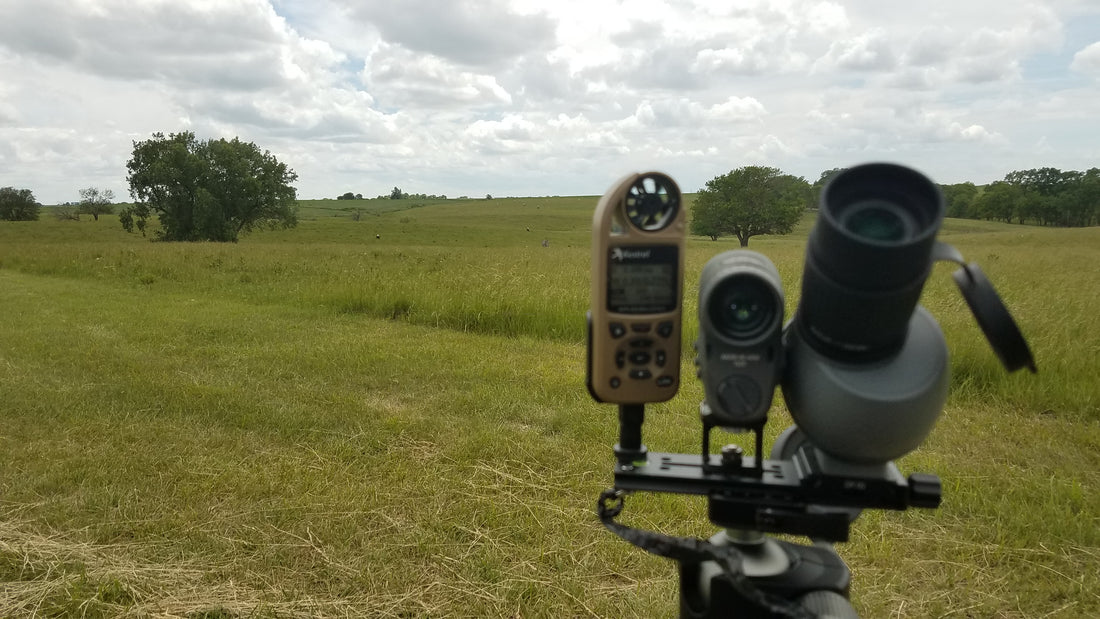My goal was to assemble a fire-station that allowed for the spotter to seamlessly control the precision-fire of a team designated shooter without the hassle of having out individual pieces of equipment. After I conducted some further research, it seemed there were a few different commercially available baseplate options out there, but nothing that really met my requirements for an all-encompassing direct-fire control-module which could tick all the boxes.
To practically direct and control the shooter, the fire-station would need a spotting scope, laser rangefinder (LRF), and weather station with ballistic solver. I already owned a Vortex RAZOR 11-33 spotting scope, Vortex RAZOR 4000 LRF, and Kestrel 5700, so it was just a matter of assembling everything in the most practical configuration. The LRF would allow for quick and stable ranging of targets, the Kestrel 5700 weather station with ballistic solver would facilitate calculation of a firing solution, and the spotting scope would allow the spotter to observe and adjust precision fire under increased magnification for longer range engagements. This combined capability would all come from a single tripod mounted and stabilized baseplate, making a complete fire-station for controlling precision team fire. It’s highly unlikely I’d ever be using the fire-station for night engagements, so I didn’t consider it functionally necessary for night-optic mounting capability. This subsequently ruled out the requirement of a forward mounting plate, which simplifies things a little bit when VAS mounting is unnecessary.
The next consideration was the vertical and horizontal mounting position of the individual pieces of equipment for maximum functionality and usability. Since I’m right-eye-dominant, I opted to position the spotting scope on the right side of the baseplate. The LRF would be mounted next to the spotting scope, followed by the Kestrel 5700 Weather Station. There was a height difference that exists between the spotting scope and the LRF eye pieces when mounted alongside each other, so it became necessary to source an arm bracket component to vertically “prop up” the LRF. Employing a bracket meant I could establish the LRF eye piece position right next to the spotting scope eye piece for easy transition between the two optics. Secondarily, the bracket allowed me to horizontally co-align the LRF field of view with the spotting scope field of view so all fire-station optics would be aimed at the same target. This mitigates having to align both the LRF and spotting scope onto a target individually. The spotter can set and forget with by aiming one optic, which will concurrently align the other optic.
The next problem that presented was how to mount the weather station in such a way that allowed the spotter to view the device screen and access the buttons without having to remove the device from the baseplate. This problem had already been somewhat solved with a Kestrel product. I bought a Kestrel weathervane kit with the sole intention of attaching the device cradle to the baseplate. I fast realized the K5700 cradle mounted a little low on the baseplate, which hindered the spotters’ ability to read directly from the screen while remaining on the glass with the dominant eye. A quick fix nonetheless with a trip to the hardware store to source a small grommet/spacer to “prop up” the cradle from the baseplate. Mounting required a small amount of testing and adjusting the rotation angle of the device screen to get the position just right for the spotter while remaining on the spotting scope. The K5700 bracket design also allows the spotter to remove the impeller cover completely, similar to how the unit would be mounted and utilized with the Kestrel weather vane kit.
Lastly, I mounted a small attachment point to the underside of the baseplate to allow for attaching a length of construction streamer. The reactive streamer provides indicator updates to wind condition changes at the team shooting location while still being viewable on the left side. Like the K5700 position, the spotter can remain on the glass with the dominant eye while keeping the non-dominant eye free for use on the K5700 screen or wind indicator. It seems like a minor issue, but those small “one percenters” shave seconds, making the team functionally more effective and efficient when going up against the clock or on a two-way range.
I should caveat everything by saying this blog post isn’t the only answer for assembling a fire-station, but it does give the reader some insight into my consideration factors. Ultimately, the type of shooting application should drive what equipment or optics are employed and how the fire-station is assembled. Give some serious thought to maximizing functionality through equipment placement before mounting all fire control equipment to one baseplate:
- A phone clamp might be a better option if employing a ballistic solver app on a PDA or cell phone, rather than using a K5700 bracket.
- Fixing a lanyard and Kestrel Drop 3 to the underside of a baseplate might be a good combination for local atmospheric readings when paired with a cell phone and ballistic solver app.
- Some shooting disciplines provide the target ranges for each course of fire, making it unnecessary to utilize an LRF.
- Some shooting disciplines may not have target placed at longer ranges, making it unnecessary for a spotting scope. Maybe a pair of high powered binoculars would suffice for spotting.
- Ranging and spotting capabilities can sometimes be maximized by employing LRF binoculars, rather than two individual optics for ranging and spotting.
- Consider the ranging capability of an LRF to ensure the unit will always be capable of ranging targets at the maximum expected engagement ranges.
- A spotting scope with a reticle will provide more accurate shot correction and subsequently increased second round reengagement success.
- A spotting scope without a reticle may provide a clearer field of view when observing impact and bullet splash at extended ranges.
- A VAS mounting bracket may be necessary for use with night-optics if night engagements are a perceivable scenario.
- The fire-station may benefit from having additional mounting points above or below the spotting scope for laser aiming devices and scope mounted LRF units such as the Wilcox RAPTOR-S.
- A red dot sight can be beneficial to quickly aim the fire-station in the general target area before "going on glass".
- It might be necessary to mount the spotting scope to the baseplate with an individual bracket clamp and plate to allow the spotting scope to be easily removed from the rest of the fire-station. This would facilitate quick optic replacement with a thermal or night spotting unit.
- The fire-station baseplate may require ARCA or picatinny mounting solutions, or may screw directly into the tripod ball-head itself.
- An ARCA baseplate will allow the shooter to slide and balance the fire-station onto the tripod ball-head when mounting.
After making some minor position adjustments and tweaks, I finished with a highly functional fire-station which meets the needs of the team spotter in almost any perceivable scenario.
Thanks for reading. If you enjoyed this content, be sure to subscribe, share, and follow us on YouTube, Facebook, and Instagram.

